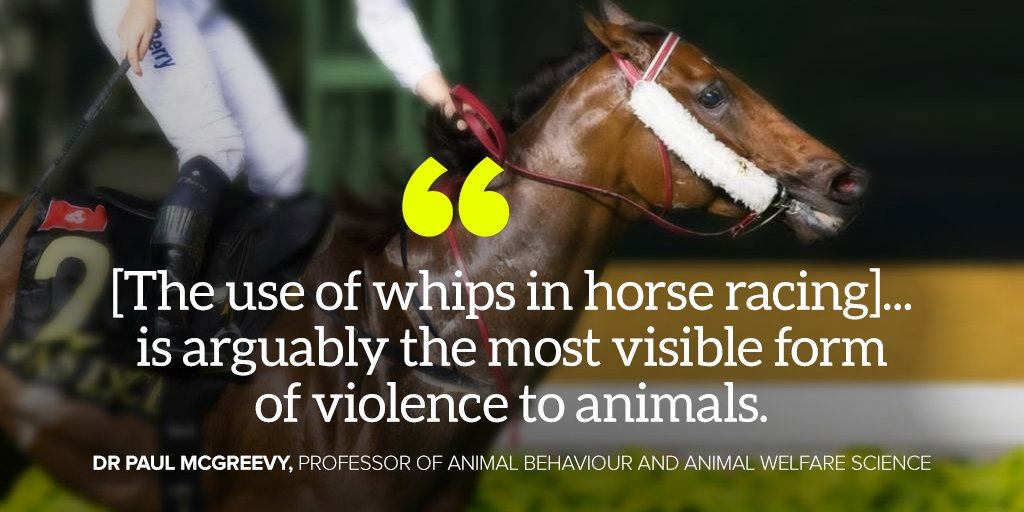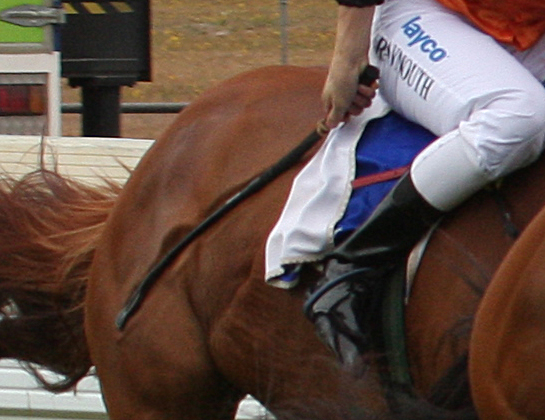With support from the Coalition for the Protection of Racehorses (CPR), People for Ethical Treatment of Animals (PETA) have filed a case that will challenge the legitimacy of whips in horse racing. Court documents were filed on Friday 8th October in the Magistrate’s Court in Hobart.

PETA Australia and the Coalition for the Protection of Racehorses (CPR) met with the animal welfare manager for Tasracing, Tasmania’s racing authority, several years ago, to express concern over the use of whips, point out that whipping violates the state’s anti-cruelty statute, and offer support to help implement changes.
Both groups then co-signed a letter with animal protection groups World Animal Protection and Animal Liberation, to Tasracing, requesting a meeting to discuss the issues and see if there was a way forward. In the subsequent meeting with PETA Australia’s lawyer and Tasracing CEO Paul Eriksson, Eriksson refused to engage further and informed PETA Australia that Tasracing had no plans to explore banning or restricting whips.
Because of the unusual status of the racing rules under the Tasmanian Animal Welfare Act 1993 and most other state’s animal protection Acts, whipping horses during racing has long been given an unofficial free pass. The court case will challenge this anomaly that means horses are whipped on racetracks despite it being a clear breach of animal welfare laws.
If you did exactly the same thing to any other animal, you would be charged with animal cruelty. This case highlights whipping a horse is a crime both on and off the racetrack.

The purpose of the whip is to keep a horse running when they are really wanting to slow down because of fatigue. This is when horses are running out of fear and on adrenalin, in circumstances that can lead to serious injury or even catastrophic breakdown.
The racing industry for years has claimed that the whip doesn’t hurt. If it doesn’t hurt and cause fear and distress, it begs the question, why use it?
A peer-reviewed study published on November 11, 2020 found ‘Humans and horses have the equivalent basic anatomic structures to detect pain in the skin’ (available here), something the racing industry continues to deny.
The report’s author, Professor Paul McGreevy, stated “We’re saying that although horse skin is thicker overall than human skin, the part of the skin that is thicker does not insulate horses from pain that is generated during a whip strike”.
CPR has put the challenge to any jockey to be whipped like a racehorse and then maintain the whip doesn’t hurt.
If it‘s not already abundantly obvious that whips hurt and cause unnecessary pain and suffering, then there is a mountain of evidence that confirms this.
This case is asking a magistrate to confirm that whipping racehorses causes unreasonable and unjustifiable pain. If such a conviction is handed down, it will be even more ludicrous for the industry to continue to deny this.
Beating horses with a whip is just the tip of the iceberg in this cruel and ruthless industry. Successful convictions will have serious ramifications not only for horse racing in Australia, but the entire world.


Horse racing is a cruel industry full of corruption and greed.
Thanks to everyone for helping the horses that have no voice. The racing industry is cruel and the only master they listen to is money.
Thank you again
Gail
The lack of willingness for the racing industry to stop this practice is an extreme example of maintaining cognitive dissonance. It is not even rational from a business perspective as the racing industry loses ever more of its social license. In other words this practice is an example of insanity and because the industry is propped up by government subsidies we all get to share the madness. I commend CPR and PETA for taking this action. As an Animal Justice Party candidate I promise that when I am elected I will do all I can to withdraw subsidies and to ensure the welfare and humane treatment of horses until they are no longer exploited for gambling entertainment.
Whips are not needed in Racing even from a safety perspective they are dangerous because if a horse needs to be moved forward in a race or the Jockey feels that hitting the horse with the whip will be the best option for making it run faster or getting out of the way of other horses, in that moment when the Jockey stops riding the horse by taking his hands off the reins to flog the horse with the whip he or she is actually Interfering in the natural motion of the horse. This is why some horse’s will not benefit from the whip as the horse is not entirely sure what the sudden change may mean or infer depending on the familiarity of the horse to a whip or I it’s been trained to know what is expected when the natural motion is broken. This also gives the horse an opportunity to dip swerve pigroot or hump as control of the head has been compromised by the Jockey now only controlling the head or one side of the head with one hand. I would go as far as to say this is a highly irresponsible tactic and depending on the age of the horse and it’s experience probably a dangerous one for surrounding horse’s and riders. If we want to ban the whip we need to look at these science and the science clearly shows that swerving dipping shying all take place when whips are pulled on horse’s and with only one hand on the reins science clearly shows that the Jockey has no real control but relies only on the temperament of the horse and the fence that guides the horse. Removing the whip will improve horsemanship over all and is the best way Forward to clean up an Industry with so many faults as statistics are coming to light through organizations such as the Coalition for horse’s. You doing a great job Cheers!?!!!!
I race, and the whip is needed, unfortunately some horses do need the whip, but im only allowed to flog the horse hard on his butt 7 times during the race, and in the straight i admit that i do whip the horse hard to keep the horse going, to try and a good placing.